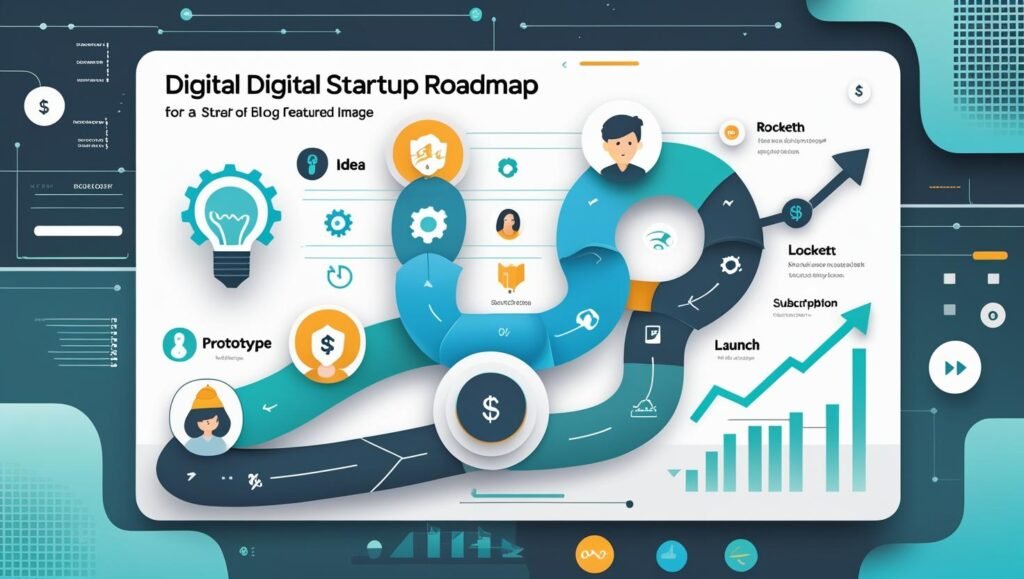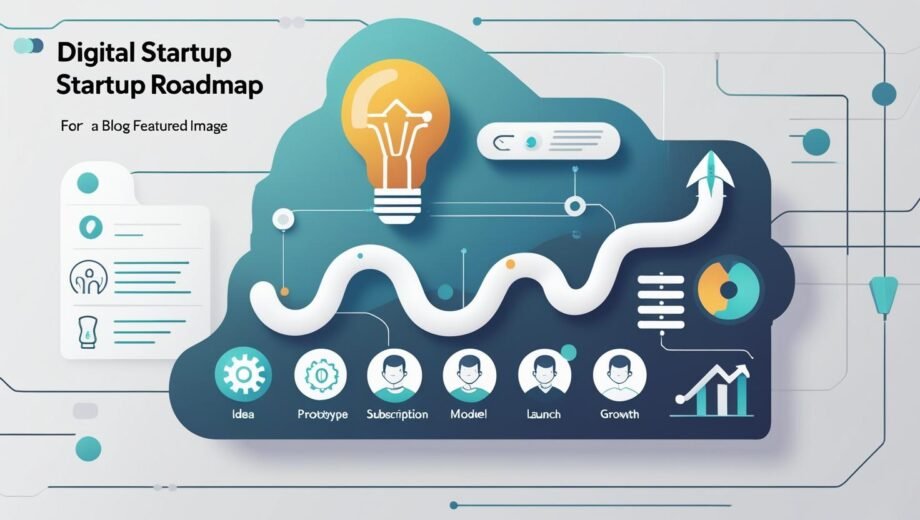Introduction
Thinking about building a SaaS startup but don’t know where to begin? You’re not alone. With the rise of cloud-based services and subscription models, Software-as-a-Service (SaaS) is one of the most scalable and profitable business models today. Whether you’re targeting enterprise clients in the USA or bootstrapped businesses in India, the opportunity is massive.
This step-by-step SaaS development roadmap is your ultimate guide to turning an idea into a profitable product. From defining your MVP to selecting the right tools and hiring developers, here’s everything you need to launch a SaaS business in 2025 and beyond.

What is SaaS and Why Now is the Right Time?
SaaS stands for Software-as-a-Service, a model where users access software over the internet via subscription. Unlike traditional software that is bought and installed once, SaaS platforms offer ongoing access, updates, and support.
Why SaaS now?
- The global shift to remote work
- Low upfront costs for users
- High profit margins for founders
- Recurring revenue models
According to industry reports, SaaS revenue in the USA alone is projected to cross $200 billion by 2027, while India is becoming a global outsourcing and startup hub.
Step-by-Step SaaS Development Roadmap
Here’s a structured path to follow from concept to launch:
- Identify the Problem and Validate the Idea
- Conduct surveys and interviews
- Use platforms like Reddit, Indie Hackers, and Quora to research demand
- Conduct surveys and interviews
- Define Your MVP (Minimum Viable Product)
- Focus on the core feature that solves one major problem
- Prioritize speed over perfection
- Focus on the core feature that solves one major problem
- Market Research and Competitive Analysis
- Analyze what tools are already available
- Study subscription pricing models and user acquisition tactics
- Analyze what tools are already available
- Design the UI/UX
- Use Figma, Sketch, or Adobe XD
- Build wireframes and get early feedback
- Use Figma, Sketch, or Adobe XD
- Develop the Product
- Choose your tech stack (React, Node.js, etc.)
- Set up the backend and database
- Choose your tech stack (React, Node.js, etc.)
- Test Internally and with Early Users
- Perform bug testing, QA
- Launch private beta with a selected group
- Perform bug testing, QA
- Implement Subscription and Billing
- Use platforms like Stripe for payments
- Offer monthly/yearly plans
- Use platforms like Stripe for payments
- Launch Publicly and Market Aggressively
- Submit to Product Hunt, Hacker News
- Run ads on Google and LinkedIn
- Submit to Product Hunt, Hacker News
- Track, Analyze, and Iterate
- Use Mixpanel, Google Analytics
- Iterate based on real user feedback
- Use Mixpanel, Google Analytics
SaaS Metrics That Matter: What to Track Post-Launch
Once your SaaS is live, tracking performance metrics is crucial. Focus on:
- MRR (Monthly Recurring Revenue): Core revenue metric for SaaS
- CAC (Customer Acquisition Cost) vs LTV (Lifetime Value): Helps measure profitability
- Churn Rate: Tracks how many customers leave your platform
- Activation Rate: Measures how quickly new users get to their first “success moment”
MVP and Beyond: Launching a Scalable SaaS Product
Your MVP is your proof of concept. The goal is not to impress everyone, but to validate demand quickly. Once you have early adopters, use their feedback to refine features and identify new opportunities.
Important post-MVP steps:
- Add value, not features
- Scale infrastructure only when necessary
- Prepare for churn and focus on retention
For a deeper dive into performance indicators, this guide on SaaS growth metrics by Baremetrics breaks down everything from MRR to churn rate.
Choosing the Right Subscription Model
One of the key elements of SaaS success is the subscription model you choose. Options include:
- Freemium: Free basic plan with paid premium features
- Tiered Pricing: Multiple levels based on usage or features
- Pay-as-you-go: Based on consumption (popular for APIs and infrastructure tools)
Your pricing should reflect value, not just cost. Always A/B test pricing pages and gather user behavior insights.
If you're exploring alternative or complementary revenue streams, here's a guide on 7 best ways to make money selling digital products that align perfectly with a SaaS business model.
Tools and Platforms to Jumpstart Your SaaS Startup
Use trusted startup guide platforms and tools to fast-track your progress:
- HubSpot: CRM, email marketing, and automation
- Stripe: Payments and billing infrastructure
- Notion or Trello: Project management
- Heroku, AWS, or Vercel: Hosting solutions
These tools save time, reduce friction, and allow you to focus on building the core product.
Hire SaaS Developers: In-House vs Outsourcing in India and USA
Choosing the right team is critical. Should you hire SaaS developers in-house or outsource?
In-house (USA):
- Better control over codebase
- Easier communication
- Higher cost
Outsourcing (India):
- Cost-effective
- Access to a large pool of skilled developers
- Requires clear documentation and project management
Platforms like Toptal, Upwork, and Lemon.io can help you find vetted SaaS developers.
Marketing, Billing & CRM: Using HubSpot, Stripe, and More
Post-launch, your success depends on smart marketing and seamless user experience. Use:
- HubSpot for lead nurturing and onboarding
- Stripe for subscriptions, invoicing, and trials
- Zapier to automate marketing and billing workflows
Ensure your stack is integrated and easy to scale as your user base grows.
Legal and Compliance Considerations for SaaS Startups
Legal compliance is often underestimated during SaaS development. Make sure you:
Consider intellectual property protection for your product
Draft solid Terms of Service and Privacy Policy
Implement GDPR and CCPA compliance if targeting users in Europe or California
Use services like Stripe to handle tax compliance in different regions
How to Start a SaaS Company?
Q1: How to start a SaaS company?
Begin with identifying a pain point, validating your idea, building an MVP, choosing a monetization model, and launching. Tools like HubSpot and Stripe help you go to market faster.
Q2: How much does it cost to build a SaaS startup?
Costs range from $10,000 to $250,000+ depending on team, tech stack, and geography. India offers more budget-friendly development options.
Q3: What skills are needed?
You’ll need technical, product management, marketing, and customer support skills. Or a team that covers these areas.
If you're unsure where to start, check out this GDPR compliance checklist for SaaS from GDPR.eu to stay compliant across markets.
Avoiding Common Pitfalls in SaaS Startups
Most SaaS startups fail not due to bad products, but due to:
- Poor product-market fit
- Overbuilding before validation
- Weak onboarding and support
- Ignoring customer churn metrics
Stay lean, validate fast, and use data for every decision.
Real-World SaaS Startup Success Stories
- Freshworks (India): Went from startup to NASDAQ listing in under a decade
- Notion: Bootstrapped initially, now valued at billions
- Calendly: Achieved product-market fit with a simple, focused MVP
- Learning from others helps avoid repeating their mistakes and inspires innovation.
Conclusion
Building a SaaS business isn’t easy, but it’s absolutely doable with the right guidance. Follow this step-by-step SaaS development roadmap to increase your chances of success. Whether you’re developing your MVP, planning your pricing model, or deciding to hire SaaS developers, every phase matters.
With rising demand in both the USA and India, now is the perfect time to act. Your SaaS startup could be the next big name in tech.







